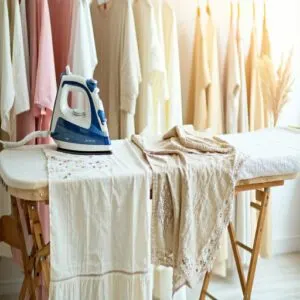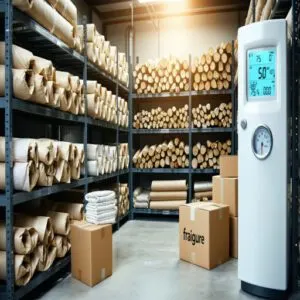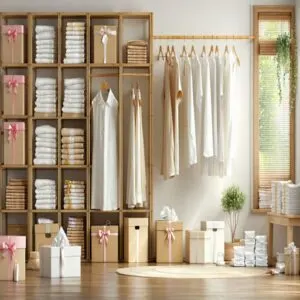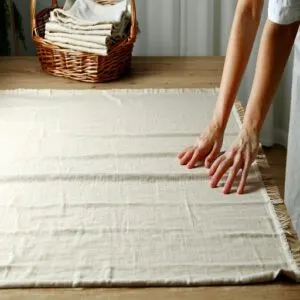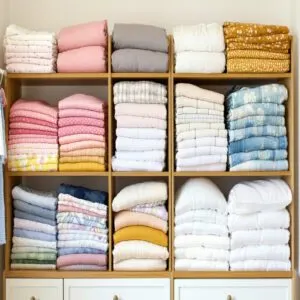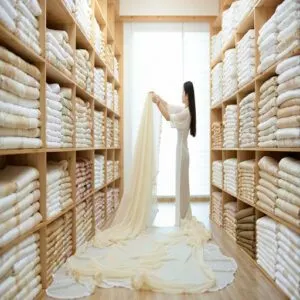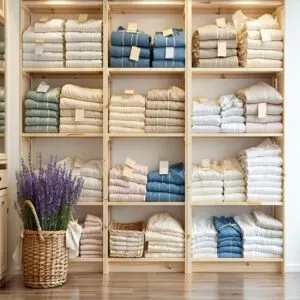This site is supported by our readers. We may earn a commission, at no cost to you, if you purchase through links.
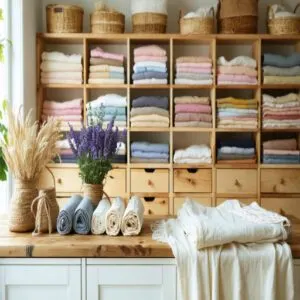 Storing fabric to prevent damage is simple if you follow a few smart steps.
Storing fabric to prevent damage is simple if you follow a few smart steps.
Keep fabrics clean before storing—oil and dirt can wreak havoc over time.
Store them in a cool, stable environment with humidity levels between 40% and 50%, and avoid direct sunlight to prevent fading.
Use acid-free materials like tissue paper or storage boxes to protect fibers from yellowing, and fold fabrics along their natural grain to avoid creases.
Add cedar or lavender sachets to fend off moths naturally, and check on them regularly for pests or damage.
Want perfect preservation? It’s all about thoughtful care and consistent checks!
Table Of Contents
Key Takeaways
- Keep fabrics clean and dry before storing to prevent dirt, oil, and moisture damage.
- Store fabrics in a cool, stable, and dark environment with humidity levels between 40%-50% to avoid fading, mold, or damage from temperature fluctuations.
- Use acid-free tissue paper, boxes, or garment bags to protect fibers from yellowing and deterioration, and fold along the natural grain to prevent creases.
- Add natural repellents like cedar or lavender sachets to fend off pests, and inspect regularly for damage or unwanted changes.
Preventing Fabric Damage
You’ll need to protect your precious fabrics from their three biggest enemies: harmful light exposure, unstable temperatures, and sneaky dirt buildup.
With proper storage techniques and the right environment, you can keep your fabric collection looking fresh and feeling fabulous for years to come.
Minimizing Light Exposure
Light protection methods are vital for your fabric’s longevity, as UV damage can be devastating.
Keep your precious textiles in dark storage areas or use UV filtering window treatments to shield them from harmful rays.
Consider breathable storage containers with UV protection capabilities – they’re like sunscreen for your fabrics.
For color preservation, avoid placing fabric near windows, and opt for shade management techniques in your storage space.
To achieve the best results, follow fabric storage tips to maintain the quality and integrity of your fabrics over time.
Controlling Temperature and Humidity
Keep your fabric happy with well-managed climate control.
Use humidity meters to maintain humidity levels between 40% and 50% and guarantee moisture management prevents damage like mold.
Temperature control matters, so keep it steady between 65°F and 70°F for ideal thermal regulation.
Stable air quality and humidity-regulated storage create the perfect environment for preserving your fabrics.
For more information on textile preservation, consulting a textile care expert can provide valuable insights into maintaining the perfect conditions.
Preventing Dirt and Oil Buildup
Start with fabric prewashing—it’s your first line of defense against dirt and oil buildup.
Dirt prevention isn’t glamorous, but skipping this step risks stains or weakening fibers later.
Use trusted cleaning methods and stain removal tricks to tackle residue before storage.
These fabric care techniques strengthen oil resistance, ensuring fabric protection methods that prevent fabric damage and preserve your stash effortlessly.
Choosing Storage Environment
You need to store fabrics in a cool, stable environment to avoid damage from temperature changes and moisture.
This will ensure consistent temperatures and good airflow, which will keep your fabrics fresh and protected over time.
Maintaining Stable Temperatures
Temperature control is your fabric’s best friend.
Avoid storing it where wild temperature swings happen—like attics or basements.
A stable climate means fewer risks of damage.
- Stick to 60-75°F with a thermostat.
- Use thermal insulation to block heat.
- Monitor climates using thermometers.
- Prevent heat buildup by avoiding direct sunlight.
Consistent care avoids costly regrets later.
Ensuring Proper Ventilation
Without proper air circulation, fabrics can feel suffocated—give them breathing room!
Use breathable storage options like mesh bins or canvas bags to encourage fresh air flow and prevent moisture buildup.
Ventilation systems or even a small fan can boost air quality.
Avoid stale spaces; your fabrics deserve care, not confinement.
Effective use of mesh storage solutions can substantially enhance the preservation of fabrics by maintaining a dry environment.
| Examples |
|---|
| Use breathable containers |
Avoiding Drastic Temperature Fluctuations
Sudden temperature swings wreak havoc on fabric stability, causing fibers to weaken over time.
To stay ahead:
- Invest in Climate Control: Use a thermostat set between 60°F-75°F.
- Monitor Humidity Levels: Keep it steady at 40%-60%.
- Add Thermal Insulation: Avoid storing fabrics in basements or attics.
- Track with Climate Monitoring Tools: Hygrometers maintain consistent temperature regulation.
Proper handling delicate fabrics is vital for maintaining their quality and extending their lifespan.
Protect fabrics like a pro!
Selecting Storage Materials
The right storage materials protect your fabrics from damage and keep them in excellent condition over time.
Using acid-free boxes, tissue paper, and garment bags prevents acids and harmful residues from weakening fibers or causing yellowing.
Using Acid-Free Storage Boxes
When choosing fabric storage bins, acid-free materials are a must for long-term preservation.
An acid-free storage box prevents fiber deterioration and yellowing, creating an ideal archive storage solution.
These breathable materials shield fabrics from damage caused by acidic residues.
For added durability, opt for storage containers with metal edges.
Detailed labeling and regular box maintenance strategies will keep your fabrics safe.
To maximize storage efficiency, consider implementing a fabric storage system that organizes fabrics by type and weight, using a fabric storage system for optimal results.
Choosing Acid-Free Tissue Paper
Swapping dollar-store tissue for acidfree products pays off.
Fabric preservation depends on breathable materials that won’t react with textiles over time.
Look for archival supplies like acidfree tissue for wrapping your fabrics.
Using acid free tissue is essential for long-term preservation.
- Prevents yellowing and fiber breakdown
- Protects against chemical damage
- Supports long-term textile preservation
- Adds cushioning to delicate layers
- Maintains natural folds effortlessly
When quality matters, paper quality matters.
Selecting Acid-Free Garment Bags
When picking fabric storage bags, opt for garment bags made with acid-free materials to protect fibers long-term.
Look for breathable materials that prevent moisture buildup—essential in fabric protection methods.
Conduct bag durability tests for reliable storage solutions.
Among garment bag types, acid-free options are your best bet for preserving fabrics like silk or wool without harmful chemical exposure.
Using acid free products can substantially enhance the preservation quality of stored fabrics.
Folding and Storing Fabrics
Folding fabrics properly is key to preventing unnecessary wear and maintaining their strength.
By storing them along the natural grain and refolding occasionally, you can avoid permanent creases and keep them in top condition.
This approach ensures that your fabrics remain in the best possible state, making them last longer and look better over time.
Folding Along Natural Grain
In the context of fabric folding, following the grain direction keeps fibers from fighting their natural flow, which helps with fabric damage prevention.
Lay your fabric flat and check its weave—it’s like giving it a stress-free nap.
A thoughtful fold here preserves structure, prevents fabric tears, and reduces creases, which is a key part of simple fabric care.
Simple fabric care tips like this go a long way!
Using Folding Techniques
To keep your fabrics in top shape, smart folding techniques matter.
Try these simple folding patterns:
- Tri-Fold Method: Ideal for lightweight fabrics, spreading weight evenly.
- Rolled Storage: Great for heavier fabrics, reducing stress and preventing tears.
- Square Fold: Perfect for compact storage, avoiding messy piles.
Using these fabric folding tips helps prevent damage and long-term creases.
Refolding Fabrics Regularly
Refolding fabrics every few years is a clever way to prevent fabric creases and fade lines.
It redistributes pressure, promotes fiber relaxation, and avoids fabric deterioration.
Use this refolding schedule:
| Action Needed |
|---|
| Prevents fabric shrinkage |
Stay consistent!
This approach helps in maintaining the quality and lifespan of fabrics, which is essential for keeping them in good condition over time.
Maintaining Stored Fabrics
You’ll keep your fabrics in top condition by inspecting them regularly, labeling storage containers clearly, and using natural repellents to prevent pests.
Simple steps like these guarantee your stored textiles stay fresh, damage-free, and ready to use whenever needed.
Regular Inspections
Fabric care doesn’t stop at storage.
Regular fabric inspection keeps deterioration at bay, check for fabric damage like stains, holes, or fading.
Spot pests early with routine pest monitoring, rotate storage to redistribute pressure points and avoid creases.
Inventory management helps you stay organized and track fabric, consistent fabric checks guarantee your stored treasures stay fresh and usable, ensuring regular maintenance is key to their longevity.
Labeling Storage Containers
Labeling storage containers is your secret weapon for fabric storage mastery.
Use sturdy label materials to guarantee clarity and durability.
Try these tips:
- Create inventory lists with fabric codes for quick identification.
- Add container tags or storage signs with details like fabric type and yardage.
- Opt for a consistent labeling system to maintain organization across your collection.
This approach will help you achieve complete concepts of fabric storage and maintain a well-organized collection.
Using Natural Repellents
Pesky pests can ruin your fabric stash, but natural pest control methods can keep them at bay.
Use repellent herbs like lavender, cedar, or cloves for moth prevention.
Essential oils from these herbs enhance fabric safeguards and act as organic solutions.
When storing delicate items, consider techniques for handling delicate fabrics to maintain their quality and prevent damage.
Enhance pest prevention by adding small sachets or silica gel packets—easy, effective natural remedies to protect your prized fabrics.
Frequently Asked Questions (FAQs)
How do you protect fabric in storage?
Imagine your fabric fading faster than old memories.
Protect it by avoiding sunlight, keeping humidity stable, folding with acid-free tissue, and using breathable bins.
Toss in cedar or lavender to keep pests out.
What is the best container to store fabric in?
The best containers for fabric storage are acid-free boxes or breathable cotton storage bags.
These prevent acidic damage and allow airflow, unlike plastic bins, which trap moisture and risk mildew.
Label everything to stay organized and use breathable cotton storage bags to maintain airflow.
Does stored fabric deteriorate?
Yes, fabric can deteriorate over time.
Exposure to light, fluctuating humidity, and improper storage causes fibers to weaken, discolor, or grow mold.
Storing in a dark, stable, and well-ventilated space slows the deteriorate process.
Is it okay to store fabric in plastic totes?
Plastic totes can work if you verify fabrics are clean and dry first.
Use acid-free tissue to separate pieces and poke small holes for ventilation.
Avoid direct sunlight and humid spots to prevent mold or damage.
How do you safely store vintage fabrics?
Wrap vintage fabrics in acid-free tissue paper to avoid creases, then place them in acid-free storage boxes.
Store in a cool, dry space, away from light.
Check periodically for pests or humidity issues.
What storage methods work for mixed fabric types?
Rotate between folding and rolling fabrics to reduce stress on fibers.
Use acid-free tissue to separate delicate types.
Label everything clearly.
Store in temperature-controlled, dry spaces to prevent damage, keeping mixed materials safe and organized.
How to avoid color bleeding during storage?
Prevent color bleeding by separating fabrics based on color intensity.
Wash fabrics prone to bleeding before storage and make certain they’re completely dry.
Wrap delicate or bright fabrics in acid-free tissue to block moisture and dye transfer.
Can fabric be stored in vacuum-sealed bags?
Ever wonder if vacuum-sealed bags are a safe bet for fabric.
They’ll save space, but long-term use can crush fibers and trap moisture.
Skip them for delicate fabrics; breathable, acid-free storage is your best option.
How to protect fabrics from accidental water damage?
Store fabrics in waterproof containers or bins, and place silica gel packets to absorb excess moisture.
Elevate storage off the floor to avoid flooding risks.
Avoid plastic bags—they can trap moisture and encourage mildew growth.
Conclusion
Think of fabric storage as creating a safe, cozy cocoon for your textiles.
By tackling common threats like sunlight, pests, and humidity, you’ll keep fabrics in top shape for years.
Stick to acid-free supplies, fold with care, and use lavender or cedar to boost protection—the little details make a big difference.
Regular checks make it possible to spot issues early, whether it’s fading, creases, or critters, and by doing so, you ensure that storing fabric to prevent damage becomes second nature.
Follow these steps, and you will be able to maintain your fabrics in the best possible condition.
- https://www.spacecentreselfstorage.co.uk/avoiding-damage-when-storing-fabric-or-cloth-long-term/
- https://www.threadsmagazine.com/forum/storing-fabric-long-term
- https://www.nytimes.com/wirecutter/blog/how-to-get-rid-of-clothes-moths/
- https://www.gaylord.com/Preservation/Conservation-Supplies/Boards-%26-Paper/Gaylord-Archival%26%23174%3B-Unbuffered-Acid-Free-Tissue-%28100-Pack%29/p/HYB01351
- https://www.allpeoplequilt.com/how-to-quilt/organization/storage-solutions

